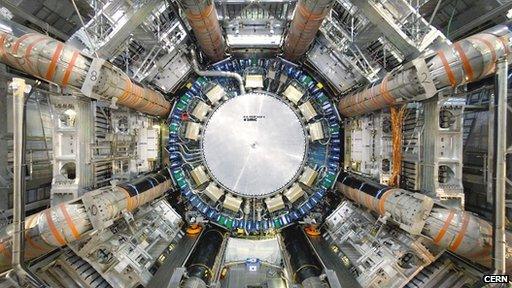Two years after Higgs boson find, what now for CERN?
- Published
- comments

The ATLAS experiment at CERN which found the Higgs boson
This will be my second visit to CERN, the European Organisation for Nuclear Research, and my first since the discovery of the Higgs boson. So why are we going back?
Well, approaching two years since the discovery of the Higgs we want to find out what next for the Large Hadron Collider? We spent £8bn building a machine to find the Higgs boson and there it was, exactly as predicted. So what new physics will the scientists look for next? Or is there still more work to be done around the Higgs itself?
It's one of our region's scientists who is at the heart of all this. Prof David Charlton from the University of Birmingham is the man now in charge of the massive ATLAS experiment. One of the two huge experiments at CERN that independently discovered the Higgs boson.
7,000 tonne experiment
When most of us think of an experiment, our frame of reference is school science lessons. A test tube and a Bunsen burner and perhaps a bit of a bang.
You might have had a lab partner to share the experiment with. Now, imagine having 3,000 of them.
That's the situation Prof David Charlton finds himself in every day.
And ATLAS itself really is huge. It is 46 metres long, 25 metres in diameter, and weighs about 7,000 tonnes.
Professor Charlton was elected by the other scientists to be the "leader" of ATLAS. I've written about him before. He's only the third person to be ATLAS leader and the first Brit.
Massive upgrade
Right now CERN is in the middle of a massive upgrade. It's a race against time to get the ATLAS experiment rebuilt before the new higher powered CERN collider starts up again next year.
But Prof Charlton has also got to keep his team, all 3,000 people from 177 different institutions, focused on analysing the pile of data they've still got to work through before the shutdown.
And he also has to sweet-talk politicians from all over the world who hold the purse strings and engage them with the idea of funding the experiment for the next decade and beyond.
So how do you do all that? Well, we'll be spending the day with him to find out.